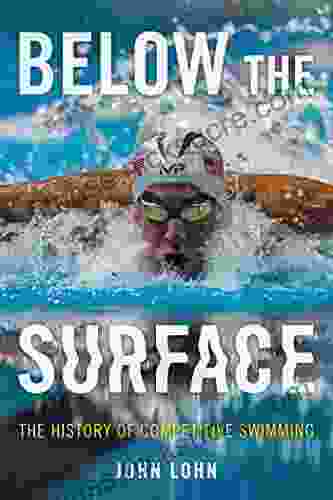Below The Surface: A Comprehensive Exploration of the History of Competitive Swimming

Prologue: The Genesis of Aquatic Prowess
Swimming, an inherent human ability, has captivated humankind for millennia. From prehistoric times, humans have ventured into water bodies, propelled by survival instincts and an innate affinity for the aquatic realm. As civilizations emerged, swimming evolved from a means of sustenance to a form of recreation and spectacle.
Ancient Origins: The Dawn of Formalized Competition
The earliest evidence of competitive swimming dates back to ancient Greece. During the Olympic Games, held every four years in honor of Zeus, athletes showcased their swimming prowess in races across the length of the Alpheus River. Roman civilization also embraced swimming competitions, with elaborate pools and aqueducts built to accommodate aquatic events.
4.1 out of 5
| Language | : | English |
| File size | : | 90465 KB |
| Text-to-Speech | : | Enabled |
| Screen Reader | : | Supported |
| Enhanced typesetting | : | Enabled |
| Word Wise | : | Enabled |
| Print length | : | 311 pages |
Medieval Era: A Period of Quietude
The fall of the Roman Empire ushered in a period of decline for competitive swimming. With the rise of Christianity and its emphasis on modesty, public bathing and swimming became frowned upon. Swimming knowledge was largely preserved by Arab scholars, who perfected diving techniques and developed rudimentary swimming strokes.
Renaissance Revival: A Rebirth of Aquatic Competition
The Renaissance witnessed a resurgence of interest in classical culture, including swimming. In 16th-century Italy, swimming competitions were held in canals and rivers, drawing large crowds. This period also saw the emergence of competitive diving, with skilled divers performing acrobatic feats from bridges and towers.
18th Century: The Birth of Modern Swimming
The 18th century marked a turning point in the history of competitive swimming. In England, Captain Matthew Webb became the first person to swim the English Channel in 1774, sparking a wave of open-water swimming competitions. Simultaneously, indoor swimming pools began to be constructed, providing controlled environments for year-round training and competitions.
19th Century: Standardization and Global Expansion
The 19th century witnessed the standardization of competitive swimming rules and regulations. In 1869, the Amateur Swimming Association (ASA) was founded in England, establishing common distances, strokes, and judging criteria. This era also saw the spread of competitive swimming to countries across Europe and North America.
20th Century: Breaking Barriers and Setting Records
The 20th century was a period of unprecedented progress in competitive swimming. Women's competitive swimming gained recognition, with the first women's Olympic swimming event held in 1912. Technological advancements, such as the of swimsuits and lane lines, improved performance and safety. Swimmers began to specialize in specific strokes, leading to the establishment of world records in each discipline.
Modern Era: Innovation and Inclusivity
The modern era of competitive swimming is characterized by continuous innovation and a focus on inclusivity. New training methods, nutrition strategies, and swimsuit designs have pushed the limits of human performance. The sport has become more accessible to swimmers of all ages, abilities, and backgrounds.
The Evolution of Competitive Swimming Techniques
Over the centuries, competitive swimming techniques have undergone significant evolution.
Pre-Modern Strokes: Primitive and Inefficient
In ancient times, swimmers employed rudimentary strokes that resembled the dog paddle or breaststroke. These strokes lacked efficiency and speed, limiting the distances that swimmers could cover.
Modern Strokes: Efficiency and Speed
The development of modern swimming strokes began in the 19th century. The crawl stroke, also known as the front crawl, emerged as the fastest and most energy-efficient stroke. It involves alternating arm movements and a scissor-like leg kick. The backstroke, butterfly stroke, and breaststroke were also standardized, each with its unique characteristics and advantages.
Continuous Refinement: The Pursuit of Perfection
Modern swimming techniques continue to undergo refinement and optimization. Biomechanics research and advancements in training methods have led to improvements in body position, stroke mechanics, and breathing techniques. Elite swimmers strive to minimize resistance and maximize propulsion, constantly pushing the boundaries of human performance.
The Impact of Technology on Competitive Swimming
Technology has played a crucial role in shaping the history of competitive swimming.
Swimsuits: A Double-Edged Sword
The evolution of swimsuits has had a profound impact on swimming performance. From simple woolen suits to high-tech polyurethane fabrics, swimsuits have provided swimmers with increased buoyancy, reduced drag, and enhanced flexibility. However, the of full-body suits in the early 21st century led to concerns about fairness and the integrity of the sport.
Pool Design and Equipment: Enhancing Safety and Performance
Advances in pool design and equipment have improved safety and facilitated faster swimming times. Stainless steel pools with smooth surfaces and lane lines have reduced water resistance and created a consistent racing environment. Underwater cameras and timing systems have enabled accurate analysis and precise measurement of performance.
Training Tools and Recovery Techniques: Optimizing Performance
Modern training tools, such as swim cords, paddles, and flippers, have provided swimmers with targeted training options to improve strength, endurance, and technique. Recovery techniques like massage and cryotherapy have become integral to the recovery process, allowing swimmers to train harder and recover more quickly.
Competitive Swimming: A Sport of Perseverance and Excellence
Competitive swimming is a demanding sport that requires exceptional physical fitness, mental toughness, and unwavering dedication.
Physical Attributes: Strength, Endurance, and Flexibility
Elite swimmers possess exceptional strength in their arms, legs, and core. They also have extraordinary endurance capacity, enabling them to maintain high-intensity efforts for prolonged periods. Flexibility is crucial for efficient strokes and minimizing drag.
Mental Fortitude: Focus, Determination, and Resilience
Swimming is a mentally challenging sport that tests swimmers' focus, determination, and resilience. Swimmers must endure grueling training sessions, manage stress, and overcome setbacks to achieve their goals.
Dedication and Sacrifice: The Path to Success
Becoming a successful competitive swimmer requires immense dedication and sacrifice. Swimmers often train multiple times a day, balancing their athletic endeavors with academic or professional pursuits. They must adhere to strict nutrition and sleep schedules, and sacrifice social activities to prioritize their training.
The Legacy of Competitive Swimming
Competitive swimming has left an enduring legacy on society.
Historical Significance: The Evolution of a Global Sport
Competitive swimming has been a part of human culture for thousands of years, evolving from ancient competitions to a modern global sport. It has played a pivotal role in promoting physical fitness, camaraderie, and international understanding.
Medical and Health Benefits: A Path to Physical Well-being
Swimming is a low-impact, full-body workout that provides numerous health benefits. It enhances cardiovascular health, improves muscle strength and flexibility, and reduces the risk of chronic diseases.
Cultural Impact: Inspiring Stories and Role Models
Competitive swimming has captured the imagination of people worldwide. The stories of legendary swimmers, such as Michael Phelps, Katie Ledecky, and Ian Thorpe, inspire awe and admiration. These athletes serve as role models for young swimmers and demonstrate the power of hard work, dedication, and perseverance.
Epilogue: The Enduring Spirit of Competition
Competitive swimming continues to thrive as a sport that combines athleticism, technique, and human spirit. It is a testament to the enduring desire for competition and the relentless pursuit of excellence. As the sport continues to evolve, it will undoubtedly leave an even more profound mark on history, inspiring future generations of swimmers to push the boundaries of human performance and achieve greatness.
4.1 out of 5
| Language | : | English |
| File size | : | 90465 KB |
| Text-to-Speech | : | Enabled |
| Screen Reader | : | Supported |
| Enhanced typesetting | : | Enabled |
| Word Wise | : | Enabled |
| Print length | : | 311 pages |
Do you want to contribute by writing guest posts on this blog?
Please contact us and send us a resume of previous articles that you have written.
 Fiction
Fiction Non Fiction
Non Fiction Romance
Romance Mystery
Mystery Thriller
Thriller SciFi
SciFi Fantasy
Fantasy Horror
Horror Biography
Biography Selfhelp
Selfhelp Business
Business History
History Classics
Classics Poetry
Poetry Childrens
Childrens Young Adult
Young Adult Educational
Educational Cooking
Cooking Travel
Travel Lifestyle
Lifestyle Spirituality
Spirituality Health
Health Fitness
Fitness Technology
Technology Science
Science Arts
Arts Crafts
Crafts DIY
DIY Gardening
Gardening Petcare
Petcare Eric Kaplan
Eric Kaplan Matthew Silverman
Matthew Silverman Alice Beck Kehoe
Alice Beck Kehoe David Armitage
David Armitage Steve O Hearn
Steve O Hearn Alexei Yurchak
Alexei Yurchak Douglas Starr
Douglas Starr John Pagano
John Pagano Sir E A Wallis Budge
Sir E A Wallis Budge Michael Patrick Ghiglieri
Michael Patrick Ghiglieri Thomas F King
Thomas F King Kirstin Cronn Mills
Kirstin Cronn Mills Damon Centola
Damon Centola Rob Price
Rob Price Jessica Riskin
Jessica Riskin Mark Elbroch
Mark Elbroch Amanda Ripley
Amanda Ripley Kathleen Mcauliffe
Kathleen Mcauliffe Robert Zimmerman
Robert Zimmerman Crysta Mchenry
Crysta Mchenry Alfred Tennyson
Alfred Tennyson Nick Mitchell
Nick Mitchell Ernie Palladino
Ernie Palladino Lonely Planet
Lonely Planet Sacha Black
Sacha Black Mikel Jollett
Mikel Jollett George Beinhorn
George Beinhorn Guy Hunter Watts
Guy Hunter Watts Kenn Bivins
Kenn Bivins Katie Walsh Flanagan
Katie Walsh Flanagan John Bemelmans Marciano
John Bemelmans Marciano Alexandra Mayzler
Alexandra Mayzler John Madieu
John Madieu Veronica O Keane
Veronica O Keane Judith Levin
Judith Levin Erica Lyon
Erica Lyon Pottermore Publishing
Pottermore Publishing Stephen Blyth
Stephen Blyth Duncan Hines
Duncan Hines Norman L Keltner
Norman L Keltner Jean Chatzky
Jean Chatzky David G Kingdon
David G Kingdon Rosary O Neill
Rosary O Neill Hape Kerkeling
Hape Kerkeling Lawrence Weschler
Lawrence Weschler Peter Flom
Peter Flom Patti M Hummel
Patti M Hummel George Takei
George Takei Elizabeth Clare Prophet
Elizabeth Clare Prophet Ryan Guldberg
Ryan Guldberg Lydia Wylie Kellermann
Lydia Wylie Kellermann Ashley Mardell
Ashley Mardell Joshua Coleman Phd
Joshua Coleman Phd Mark Sisson
Mark Sisson David A Ebert
David A Ebert Alexandra Robbins
Alexandra Robbins Roddy Scheer
Roddy Scheer Mike Dauplaise
Mike Dauplaise Erika Rogers Holland
Erika Rogers Holland John F Gilbey
John F Gilbey Alice Roberts
Alice Roberts German Raigosa
German Raigosa Michaelbrent Collings
Michaelbrent Collings Alexey Osadchuk
Alexey Osadchuk Stephen Altschuler
Stephen Altschuler Seabury Blair
Seabury Blair Michele Filgate
Michele Filgate Mark Harris
Mark Harris Wendy Wood
Wendy Wood Lyanda Lynn Haupt
Lyanda Lynn Haupt Samantha Cattach
Samantha Cattach Whitney Ferre
Whitney Ferre Penny Armstrong
Penny Armstrong Gordon England
Gordon England Penelope Leach
Penelope Leach Ben Applebaum
Ben Applebaum Lisa Manterfield
Lisa Manterfield Peter Collier
Peter Collier Robert Scott
Robert Scott Grackle Pigeon
Grackle Pigeon Hank D Haney
Hank D Haney Ryuu Shinohara
Ryuu Shinohara Michael Clark
Michael Clark Robert P Crease
Robert P Crease Susan Wise Bauer
Susan Wise Bauer Alfred Edersheim
Alfred Edersheim Margaret Starbird
Margaret Starbird Laura Gauld
Laura Gauld Zar Petkov
Zar Petkov Michael Vassallo
Michael Vassallo Paul Asay
Paul Asay Keisuke Andrew
Keisuke Andrew Bernie Clark
Bernie Clark Sue Tidwell
Sue Tidwell Penelope Freed
Penelope Freed Dr Heather L Johnson
Dr Heather L Johnson Lauren Drain
Lauren Drain Normandi Ellis
Normandi Ellis Bear Grylls
Bear Grylls Glade B Curtis
Glade B Curtis Kevin Allen
Kevin Allen C S Johnson
C S Johnson Pantea Kalhor
Pantea Kalhor Vishal Sambharya
Vishal Sambharya Charlie N Holmberg
Charlie N Holmberg Frank White
Frank White David Maidment
David Maidment K T Hanna
K T Hanna Karyl Rickard
Karyl Rickard Alexis Marie Chute
Alexis Marie Chute Louis Borgenicht
Louis Borgenicht Beccy Hands
Beccy Hands Chip K
Chip K Patrick Torsell
Patrick Torsell Courtney Kenney
Courtney Kenney Howard Pyle
Howard Pyle John C Hudson
John C Hudson Arthur Robert Harding
Arthur Robert Harding Andy Kirkpatrick
Andy Kirkpatrick Alexandra M Levitt
Alexandra M Levitt Natalie Angier
Natalie Angier Carolyn Highland
Carolyn Highland Kathryn A Bard
Kathryn A Bard Richard Moore
Richard Moore Alice Scordato
Alice Scordato David A Askay
David A Askay Jeremy Benson
Jeremy Benson Alice Miller
Alice Miller Frank C Hawkins
Frank C Hawkins Michael R Lindeburg
Michael R Lindeburg Emily Riehl
Emily Riehl Martha Sears
Martha Sears Joshua R Eyler
Joshua R Eyler Pam Withers
Pam Withers Matthew Cowsert
Matthew Cowsert Alice Kuipers
Alice Kuipers Diana Hudson
Diana Hudson Jenna Ortega
Jenna Ortega Dagny Scott Barrios
Dagny Scott Barrios Virgil Herring
Virgil Herring Shaun David Hutchinson
Shaun David Hutchinson Amy Pickar Abernethy
Amy Pickar Abernethy Wendy Currie
Wendy Currie Frank Amthor
Frank Amthor Jeff Cooper
Jeff Cooper Sam Thoma
Sam Thoma Tim Weston
Tim Weston John G West
John G West Josh Peter
Josh Peter Clay Bonnyman Evans
Clay Bonnyman Evans Ali Novak
Ali Novak Jim Vance
Jim Vance Malina Malkani Ms Rdn Cdn
Malina Malkani Ms Rdn Cdn Michael J Behe
Michael J Behe Susan Jules
Susan Jules Lauren Harris
Lauren Harris Mark C Purcell
Mark C Purcell Dean Pohlman
Dean Pohlman Jim Mclean
Jim Mclean Carol Ekarius
Carol Ekarius Ken Mink
Ken Mink Christopher Steiner
Christopher Steiner Rachel Vitale
Rachel Vitale Dan Jenkins
Dan Jenkins Lance Akiyama
Lance Akiyama Alexey Zimarev
Alexey Zimarev Tim Maudlin
Tim Maudlin Karl Wiegers
Karl Wiegers Peter Woit
Peter Woit Hicham And Mohamed Ibnalkadi
Hicham And Mohamed Ibnalkadi Patrick Ness
Patrick Ness Ellen Kane
Ellen Kane Eileen Edna Power
Eileen Edna Power Jason Selk
Jason Selk Leslie Berlin
Leslie Berlin William G Tapply
William G Tapply Anthony Legins
Anthony Legins Peter D Rogers
Peter D Rogers Alexandra Fuller
Alexandra Fuller Karin Perry
Karin Perry Alice Walker
Alice Walker Alexis L Boylan
Alexis L Boylan Jay Greenberg
Jay Greenberg Philip Freeman
Philip Freeman Nancy Roe Pimm
Nancy Roe Pimm Joy S Kasson
Joy S Kasson Michael Vlessides
Michael Vlessides Thomas Hund
Thomas Hund Complete Test Preparation Inc
Complete Test Preparation Inc Brian D Ambrosio
Brian D Ambrosio Craig S Brantley
Craig S Brantley John Pirillo
John Pirillo Bjorn Kjellstrom
Bjorn Kjellstrom Mark Kaplan
Mark Kaplan Ali Katz
Ali Katz Alexia Leachman
Alexia Leachman Alfred North Whitehead
Alfred North Whitehead Alexandra Brodsky
Alexandra Brodsky Jen Noonan
Jen Noonan Sammy Hagar
Sammy Hagar Heidi Murkoff
Heidi Murkoff Jay Golden
Jay Golden Eric Mantle
Eric Mantle Bayo Akomolafe
Bayo Akomolafe Ian Morris
Ian Morris Lara Alcock
Lara Alcock Neil J Salkind
Neil J Salkind Alice Sebold
Alice Sebold Christopher Mitchell
Christopher Mitchell David Wolman
David Wolman Jodi L Weinstein
Jodi L Weinstein Valora Conciencia En Los Medios
Valora Conciencia En Los Medios Jermaine Harris
Jermaine Harris Suzy Amis Cameron
Suzy Amis Cameron Alexia Purdy
Alexia Purdy Rev Cain
Rev Cain Aris Spanos
Aris Spanos Gen Tanabe
Gen Tanabe Kathy Barker
Kathy Barker America S Test Kitchen
America S Test Kitchen Larry Baush
Larry Baush Matthew Dektas
Matthew Dektas David R Hawkins
David R Hawkins Thomas Hill
Thomas Hill Alexandra Kennon
Alexandra Kennon Carlton Kirby
Carlton Kirby Kynan Bridges
Kynan Bridges Arthur Lydiard
Arthur Lydiard Jane Gildart
Jane Gildart Ali Almossawi
Ali Almossawi Executivegrowth Summaries
Executivegrowth Summaries Martha Shirk
Martha Shirk Krissy Moehl
Krissy Moehl Melia Keeton Digby
Melia Keeton Digby John Lohn
John Lohn Yehuda Lindell
Yehuda Lindell Milly Buonanno
Milly Buonanno Sarah K L Wilson
Sarah K L Wilson Joe Proulx
Joe Proulx Brent Warner
Brent Warner Anymom
Anymom Mary Kay Andrews
Mary Kay Andrews Ally Nathaniel
Ally Nathaniel Li Ming Lee
Li Ming Lee Tim R Swartz
Tim R Swartz Andrew Zimmern
Andrew Zimmern Les Adams
Les Adams Carmindy
Carmindy Jeremy Hance
Jeremy Hance John Abramson
John Abramson Laura Katz
Laura Katz Stephanie Mitchell Cnm Msn Dnp
Stephanie Mitchell Cnm Msn Dnp Mike Wallace
Mike Wallace Richard Preston
Richard Preston Ali Wong
Ali Wong Sarah Rayner
Sarah Rayner Alice Horton
Alice Horton Peter J Hotez
Peter J Hotez Sarah Bolitho
Sarah Bolitho Mitchell P Jones
Mitchell P Jones Gary A Klein
Gary A Klein Heather Lang
Heather Lang Oivind Andersson
Oivind Andersson Alfred Lambremont Webre
Alfred Lambremont Webre Minda Harts
Minda Harts Hollie Henderson
Hollie Henderson Paul H Frampton
Paul H Frampton Michelle Rotteau
Michelle Rotteau Arthur Ashe
Arthur Ashe Nick Kalyn
Nick Kalyn Sharon Powell
Sharon Powell Joel Weinberger
Joel Weinberger Adah Bakalinsky
Adah Bakalinsky Thao Doan
Thao Doan Alfie Kohn
Alfie Kohn Paul Wilmott
Paul Wilmott Erez Morabia
Erez Morabia Alexandria Moran
Alexandria Moran Scott Chimileski
Scott Chimileski Steve Parker
Steve Parker Zac Unger
Zac Unger Thomas Horn
Thomas Horn Sir Oliver Lodge
Sir Oliver Lodge Whitney Miller
Whitney Miller Alexis Averbuck
Alexis Averbuck William King
William King Sarah A Chrisman
Sarah A Chrisman Rails To Trails Conservancy
Rails To Trails Conservancy Matilda Betham
Matilda Betham Anders Morley
Anders Morley Nora Roberts
Nora Roberts Wade Davis
Wade Davis Matthew Bowling
Matthew Bowling Stacy Tornio
Stacy Tornio Michael Johnson
Michael Johnson Stuart Kauffman
Stuart Kauffman Jonathan Carroll
Jonathan Carroll Sarah Melland
Sarah Melland Nick Littlehales
Nick Littlehales Aram Attarian
Aram Attarian Bob Toski
Bob Toski Tom Mackie
Tom Mackie Daniel Foor Phd
Daniel Foor Phd Deborah Laird Meeks
Deborah Laird Meeks Roland Huntford
Roland Huntford Phillip Starr
Phillip Starr Corky Pollan
Corky Pollan Richard H Coop
Richard H Coop Alexandra Bracken
Alexandra Bracken Michael Mcteigue
Michael Mcteigue Lara Carter
Lara Carter Reina Donovan
Reina Donovan Eric Barker
Eric Barker Penny Warner
Penny Warner Robin G Jordan
Robin G Jordan Charles Murray
Charles Murray Frank J Tipler
Frank J Tipler Bassem R Mahafza
Bassem R Mahafza Alfred Tarski
Alfred Tarski Randy Spencer
Randy Spencer Rin Chupeco
Rin Chupeco Emma Lock
Emma Lock Alice Nobile
Alice Nobile Mark Rippetoe
Mark Rippetoe Becca Maberly
Becca Maberly Mario Cleves
Mario Cleves David Byrne
David Byrne Avi Gordon
Avi Gordon Karin Slaughter
Karin Slaughter Carmen Martinez Jover
Carmen Martinez Jover Alice Borchardt
Alice Borchardt Shannon Messenger
Shannon Messenger Hans Rosling
Hans Rosling Alice Steinbach
Alice Steinbach Eric Siegel
Eric Siegel Mike Westin
Mike Westin Frederick Courteney Selous
Frederick Courteney Selous Paul Stephenson
Paul Stephenson Eleanor Drago Severson
Eleanor Drago Severson Neil Schulenburg
Neil Schulenburg Helen Purperhart
Helen Purperhart Stephen Ilg
Stephen Ilg Henry Gilbert
Henry Gilbert Darrin Gee
Darrin Gee Sigurd F Olson
Sigurd F Olson Carol Chaitkin
Carol Chaitkin Philip Rossoni
Philip Rossoni Robert Kagan
Robert Kagan Gary Wayne
Gary Wayne David G Alciatore
David G Alciatore Ali Velez Alderfer
Ali Velez Alderfer Lindsay Grace
Lindsay Grace M Mitchell Waldrop
M Mitchell Waldrop Jonathan Weiner
Jonathan Weiner Dan Aadland
Dan Aadland Elan Golomb
Elan Golomb David Gessner
David Gessner Alicia Puglionesi
Alicia Puglionesi Dianna L Van Blerkom
Dianna L Van Blerkom Terry Marsh
Terry Marsh Malala Yousafzai
Malala Yousafzai Roy Barth
Roy Barth Daniel Goleman
Daniel Goleman Joeanna Rebello Fernandes
Joeanna Rebello Fernandes Adrian Dingle
Adrian Dingle Alice Cooper
Alice Cooper Dylan Farrow
Dylan Farrow David J Goldman
David J Goldman Alfred Begum
Alfred Begum Susan Albers
Susan Albers Alina Adams
Alina Adams Donna Bozzo
Donna Bozzo Melissa Falkowski
Melissa Falkowski Nel Noddings
Nel Noddings Crystal Waltman
Crystal Waltman Kathy Gunst
Kathy Gunst Devyn Stone
Devyn Stone Robert Lusetich
Robert Lusetich Daniel Young
Daniel Young David Travis
David Travis Lynne Robinson
Lynne Robinson Mike Commito
Mike Commito Ron Ritchhart
Ron Ritchhart Daniel M Davis
Daniel M Davis Mary Beth Knight
Mary Beth Knight Joe Dolio
Joe Dolio Heather Baker
Heather Baker Mark Zondo
Mark Zondo Suzanne Giesemann
Suzanne Giesemann Jose Albani
Jose Albani Dawn Brookes
Dawn Brookes Scott Weems
Scott Weems Said Hasyim
Said Hasyim Alice June
Alice June Helen Hodgson
Helen Hodgson G Pascal Zachary
G Pascal Zachary Brigid Moss
Brigid Moss Shaka Senghor
Shaka Senghor Michael Cave
Michael Cave Jack Batten
Jack Batten Constantine A Balanis
Constantine A Balanis Kimberly V Garner
Kimberly V Garner Karin Bojs
Karin Bojs Jill Simonian
Jill Simonian Deborah Layton
Deborah Layton Michael Thorp
Michael Thorp George S Fichter
George S Fichter Sabina Khan
Sabina Khan Jessica Goodman
Jessica Goodman Tasha Alexander
Tasha Alexander Alice Gorman
Alice Gorman Tracy Anderson
Tracy Anderson Tracy Becker
Tracy Becker Lynne Cox
Lynne Cox Jerry Lynch
Jerry Lynch Andrew Yueh
Andrew Yueh Alice Boyes Ph D
Alice Boyes Ph D Peter Stark
Peter Stark Nancy Carpentier Brown
Nancy Carpentier Brown Stacey L Bradford
Stacey L Bradford Robin Kaplan M Ed Ibclc
Robin Kaplan M Ed Ibclc Luke Reynolds
Luke Reynolds Jeff Sambur
Jeff Sambur Joseph Henrich
Joseph Henrich David J Rothman
David J Rothman Karen Kovacs
Karen Kovacs Gabriel Aluisy
Gabriel Aluisy Carl Erskine
Carl Erskine Raymond Barrett
Raymond Barrett Mary Cholmondeley
Mary Cholmondeley Leslie Anthony
Leslie Anthony Arno Ilgner
Arno Ilgner Jessica Long
Jessica Long Dustin Vaughn Warncke
Dustin Vaughn Warncke Anna Mathur
Anna Mathur Allison Saft
Allison Saft Wayne Stewart
Wayne Stewart Charles Hainsworth
Charles Hainsworth Theodore Roosevelt
Theodore Roosevelt Judy Murray
Judy Murray Paul Green
Paul Green Yvette Marquez Sharpnack
Yvette Marquez Sharpnack Udo Schaefer
Udo Schaefer Jon Moxley
Jon Moxley Rebecca Schwarzlose
Rebecca Schwarzlose Lola Glass
Lola Glass Emily Levesque
Emily Levesque Robert L Kelly
Robert L Kelly Jayson Georges
Jayson Georges Mary Johnson
Mary Johnson Alexis C Bunten
Alexis C Bunten Paige Wolf
Paige Wolf Ruby Vincent
Ruby Vincent Robert A Monroe
Robert A Monroe David Watson
David Watson Peter Gandy
Peter Gandy Dr C
Dr C Scott Linden
Scott Linden Alicia Ranoldo
Alicia Ranoldo Ted Zeff
Ted Zeff Alice Jolly
Alice Jolly Steven Pressfield
Steven Pressfield Alexandra Heminsley
Alexandra Heminsley Eric Layton
Eric Layton Kev Reynolds
Kev Reynolds Jim Walden
Jim Walden Vicki Manning
Vicki Manning Jonny Bowden
Jonny Bowden Karen Mcquestion
Karen Mcquestion Nic Sheff
Nic Sheff Peggy Vincent
Peggy Vincent Doc Norton
Doc Norton Romina Garber
Romina Garber Chase Kosterlitz
Chase Kosterlitz Patricia A Mckillip
Patricia A Mckillip Heinrich Cornelius Agrippa Von Nettesheim
Heinrich Cornelius Agrippa Von Nettesheim
Light bulbAdvertise smarter! Our strategic ad space ensures maximum exposure. Reserve your spot today!

 Tyler NelsonNarrative of Nine Years Spent Amongst the Game of the Far Interior of South...
Tyler NelsonNarrative of Nine Years Spent Amongst the Game of the Far Interior of South... Mark TwainFollow ·7.9k
Mark TwainFollow ·7.9k Julian PowellFollow ·14.7k
Julian PowellFollow ·14.7k David BaldacciFollow ·6.8k
David BaldacciFollow ·6.8k D'Angelo CarterFollow ·9.1k
D'Angelo CarterFollow ·9.1k Ernest HemingwayFollow ·7.6k
Ernest HemingwayFollow ·7.6k Corbin PowellFollow ·16.9k
Corbin PowellFollow ·16.9k Emilio CoxFollow ·12.1k
Emilio CoxFollow ·12.1k Fred FosterFollow ·6.8k
Fred FosterFollow ·6.8k

 Derek Bell
Derek BellReflections For Your Heart and Soul: A Journey of...
In the depths of...

 Joseph Conrad
Joseph ConradThe Heroines Club: Empowering Mothers and Daughters
The Heroines Club...

 Milan Kundera
Milan KunderaThe First Kormak Omnibus: A Literary Expedition into the...
Prepare to embark on an extraordinary literary...

 W.H. Auden
W.H. AudenThe Color Purple: A Journey of Love, Resilience, and...
The Color Purple, a groundbreaking novel...

 Harvey Hughes
Harvey HughesTemporal Anomalies and Replacement Theory: Unraveling the...
: The Enigma of Time Time,...
4.1 out of 5
| Language | : | English |
| File size | : | 90465 KB |
| Text-to-Speech | : | Enabled |
| Screen Reader | : | Supported |
| Enhanced typesetting | : | Enabled |
| Word Wise | : | Enabled |
| Print length | : | 311 pages |












